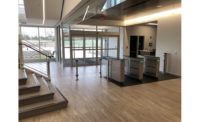Mike Barnes, founder of Barnes Associates, an investment banking firm that handles both buy and sell sides in the security industry, doesn’t consider himself a prognosticator, which is good, because he said he was dead wrong in his estimates that 2023 would be essentially flat. “It was a really, really good year,” Barnes told attendees at the recent Barnes Buchanan, held February 8-9 in West Palm Beach, Fla.
This year’s event was the best attended since pre-COVID, and began in earnest (after what Barnes described as a morning “pre-game” session on preparing a company for sale and multi-state tax issues) with company presentations from ADS, Brinks Home, Elite ISI, PEAK Alarm, and Zeus Fire and Security. Many of these featured fascinating company stories, such as the one Nick Bonifas, COO of ADS, told about joining the company and having all six owners including the founder simultaneously decide to retire and step away.
Brinks’ Chief Financial Officer Tom Kim and CEO William Niles outlined how the company has transformed over the past four years, following a complete restructuring in 2019 and reduced their attrition from 18 percent to 12.5 percent.
PEAK Alarm CEO Don Weakly talked about his company’s history and success. This was followed by Scott Elkins, CEO of Zeus Fire and Security, who explained the “hedgehog concept” — a business principle that describes three intersecting circles including what you are deeply passionate about; what you can be best in the world at; and what drives your economic engine — complete with a stuffed hedgehog prop. Elkins introduced his two-year-old company to the Barnes attendees.
Elite Interactive Solution’s Founder and CEO Aria Kozak and President Michael Zatulov discussed their company’s focus on video-based perimeter security and RMR-based services around that, noting that their company has experienced a 29 percent CAGR RMR growth with this approach.
This was an excellent foreshadowing of some of the later afternoon discussion.
But first up after a short networking break was the keynote speaker. This year it was Dan Bresingham, CEO of Everon, the recently renamed spun-off integration division of ADT. Bresingham explained how the new name was suggested by an employee and just seemed to fit the company’s vision. “We have had a lot of fun with the new name and coming up with slogans,” he said. He also teased news that the company will be closing its 6th deal next month. For more on this transition, listen to this recent SDM Podcast with Everon Chief Marketing Officer Beth Tarnoff.
This year, Barnes Buchanan chose to highlight a technology for its afternoon session — in this case video monitoring, featuring company CEOs Daniel Forrest of EyeForce, Chris Brown of Immix and Markus Scott of EyeQ Monitoring talking about the opportunity video monitoring presents security dealers and integrators as well as some of the do’s and don’ts.
“If you are not doing video monitoring today and you have 1,000 cameras you have hung on walls all over the area, you are really missing some good RMR,” Brown told attendees.
As has become tradition, the first day closed out with the official presentation of the 2023 SDM Dealer of the Year trophy to PEAK Alarm.
But as anyone who has attended a Barnes Buchanan conference knows, the highlight of the event — and the reason the room is always full at 8:30 a.m. the day after the included cocktail and dinner — is Mike Barnes annual presentation.
In addition to giving attendees the good news about last year’s performance, Barnes walked through an in-depth look at the numbers, as well touching on both threats and opportunities, and doing his best to “predict” for next year.
“Economists last year were sure we were headed into a recession,” Barnes said. “Most of us thought 2023 was likely to be a flattish kind of year — still growth, but flat. Boy, were we wrong. And that is a good thing. What ended up happening is we had an absolutely fabulous year in 2023.”
All indications Barnes pointed to look good for the security industry, even in uncertain times. While the security industry did retract in 2020 — due to installation revenue — Barnes noted that it just retreated back to the year before COVID, which is what happened during the great recession as well. “That is the beauty of this industry; not many industries can claim that,” Barnes noted. “This really speaks to the resilience of the security industry and its super attractive dynamic.”
Since that time the industry has been tracking at about 5 percent growth each year. Looking at more specifics from last year: installation was up 9 percent and monitoring up 5 percent. “Everything is boding well for the industry,” he said.
When he spoke at last year’s conference, Barnes strongly advised security dealers and integrators to consider raising prices — including on monitoring — to combat inflation. This year, he was pleased to report that many did so, and these numbers reflect that.
“A lot of the industry really did a good job in our estimation of raising prices; The industry was right to do that,” Barnes said. “Everybody saw inflation coming and everyone cringes at price increases. Inflation is painful. But the industry leaned in hard. We had clients that raised prices 5 or 8 percent, with very little fallout. That really helped on margins, big time.”
Looking at those margins, Barnes noted that margins on monitoring services were up — 50.9 percent in 2023 versus 50.8 percent in 2022. While that may not sound like much, margins have been slowly declining for almost a decade from a high of 54.3 percent in 2015.
“This is huge,” Barnes said, further explaining: “A lot of the growth started to come from additional services like Alarm.com. They were nice add-ons but if you didn’t mark them up to a 54 percent margin or higher they would drag that margin down. In 2023 for the first time we saw that number go up very slightly. This is real. I think it is predominately because of price increases.”
The question, Barnes said, is will it be sustained? Just as he did last year, he put a word of advice out there for security dealers and integrators: “A skillset the industry needs is how to raise prices on services. You guys provide great services, so charge for it.”
In more good news, Barnes said the RMR creation multiple is down, which is “astoundingly wonderful.” That multiple fell from 28.6x to 27.7x. “This is one of the biggest drops we have seen in a while, and a lot of it has to do with those price increases.”
On the topic technology opportunities, Barnes circled back to the previous day’s highlighting of video monitoring as a key opportunity.
“The larger commercial segment is up and accelerating,” Barnes said. “The hot space is the video segment. There is no question this is the place the industry is really moving hard towards and where the future lies. … Imaging, AI, it is amazing what the opportunities are for this segment. Our best guess is 15 percent growth.”
Barnes continued, “Every player has to develop some skills around [video monitoring] because if not, customers will go to specialty providers. … We think video’s time has come. It is the next explosive component of the industry.”
Every year, Barnes puts together a slide show that includes arrows from red to green in terms of threats. Video is the big opportunity coming out of Barnes Buchanan. But what are the possible threats?
Not surprisingly, first up was inflation. Barnes still puts this in the “orange” between high (red) and low (green), but it is down from the previous year. “Even though it came down a bit, there are a lot of people managing companies today that are young enough they are not familiar with a high inflation economy,” Barnes said.
Capital shortage is the next threat, which is in the low moderate range, said Joe Thompson of Barnes Associates. “Lenders are still relatively conservative and interest costs are way up.”
High interest rates mean the interest cost on debt rose 62 percent, Thompson said. This is one of the reason a healthy number of security companies worked to get debt-free last year.
For those still paying on debt or considering getting loans for transactions, Thompson gave some hope that interest rates are expected to be cut this year. However, he added: “For those borrowing, don’t expect interest rates to go higher, but don’t put confidence in them going down significantly and fast.”
The last threat, as was the case last year, was the highest: operating complexity, which is in the orange/red and climbing.
“This is the single biggest threat to the average company operating in this space,” Barnes said. “It speaks to the consolidation in the industry. A lot of company owners are saying, ‘I’m good at what I do; I had a good run, but this is just too much, too fast.”
Industry consolidation has been happening for years, Barnes added, but not as fast as many assume. “Our prediction is we will stay fragmented for a time but slowly do more consolidation.”
For those looking to buy or sell, the market is still vigorous, Barnes said. But with the higher interest rates, there has definitely been some softening, with fewer transactions. On the positive side, there are more buyers and more money — albeit at a higher price tag — and all the operating metrics are really strong.
So what about that infamous prediction Barnes doesn’t like doing? This year he played it fairly safe: “Generally speaking, industry-specific there is nothing materially changing form 2023. There is nothing fundamentally weird right now. The market will trade mostly based on the same factors as last year, which include higher interest rates, continued inflation and continued labor and supply chain issues.”
Is he correct? Check in next year to see.






